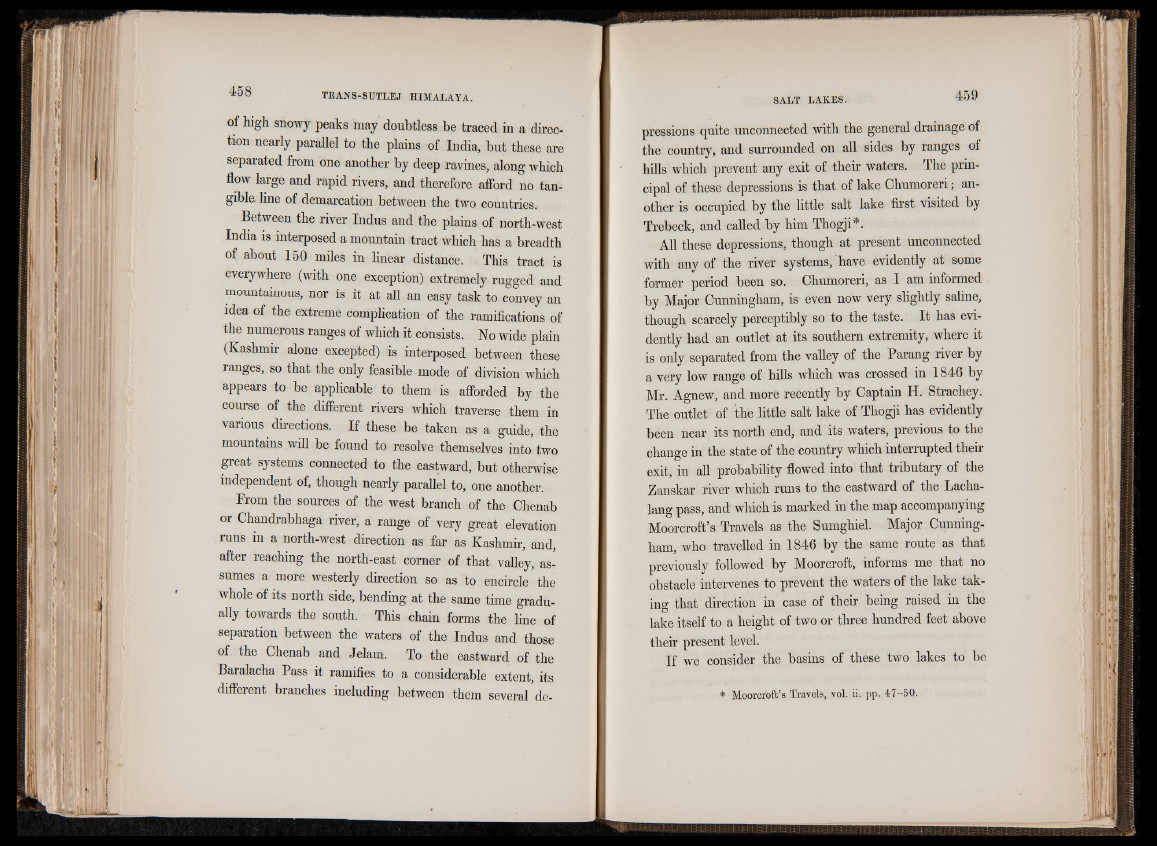
of high snowy peaks may doubtless be traced in a direction
nearly parallel to the plains of India, but these are
separated from one another by deep ravines, along which
flow large and rapid rivers, and therefore afford no tangible.
line of demarcation between the two countries.
Between the river Indus and the plains of north-west
India is interposed a mountain tract which has a breadth
of about 150 miles in linear distance. This tract is
everywhere (with one exception) extremely rugged and
mountainous, nor is it at all an easy task to convey an
idea of the extreme complication of the ramifications of
the numerous ranges of which it consists. No wide plain
(Kashmir alone excepted) is interposed between these
ranges, so that the only feasible mode of division which
appears to be applicable to them is afforded by the
course of the different rivers which traverse them in
various directions. If these be taken as a guide, the
mountains will be found to resolve themselves into two
great systems connected to the eastward, but otherwise
independent of, though nearly parallel to, one another.
From the sources of the west branch of the Chenab
or Chandrabhaga river, a range of very great elevation
runs in a north-west direction as far as Kashmir, and,
after reaching the north-east comer of that valley, assumes
a more westerly direction so as to encircle the
whole of its north side, bending at the same time gradu-
ally towards the south. This chain forms the line of
separation between the waters of the Indus and those
of the Chenab and Jelam. To the eastward of the
Baralacha Pass it ramifies to a considerable extent, its
different branches including between them several depressions
quite unconnected with the general drainage of
the country, and surrounded on all sides by ranges of
hills which prevent any exit of their waters. The principal
of these depressions is that of lake Chumoreri; another
is occupied by the little salt lake first visited by
Trebeck, and called by him Thogji*.
All these depressions, though at present unconnected
with any of the river systems, have evidently at some
former period been so. Chumoreri, as I am informed
by Major Cunningham, is even now very slightly saline,
though scarcely perceptibly so to the taste. It has evidently
had an outlet at its southern extremity, where it
is only separated from the valley of the Parang river by
a very low range of hills which was crossed in 1846 by
Mr. Agnew, and more recently by Captain H. Strachey.
The outlet of the little salt lake of Thogji has evidently
been near its north end, and its waters, previous to the
change in the state of the country which interrupted their
exit, in all probability flowed into that tributary of the
Zanskar river which runs to the eastward of the Lacha-
lang pass, and which is marked in the map accompanying
Moorcroft’s Travels as the Sumghiel. Major Cunningham,
who travelled in 1846 by the same route as that
previously followed by Moorcroft, informs me that no
obstacle intervenes to prevent the waters of the lake taking
that direction in case of their being raised in the
lake itself to a height of two or three hundred feet above
their present level.
If we consider the basins of these two lakes to be
* Moorcroft’s Travels, vol. ii. pp. 47-50.